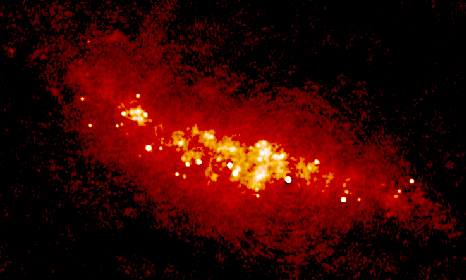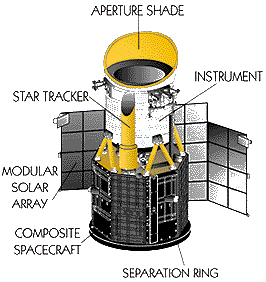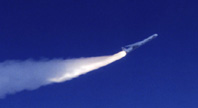 |
 |
WIRE stands for Wide Field Infrared Explorer. It is part of NASA's Small Explorer (SMEX) Program and was selected in 1994 for launch in 1999. WIRE is also one of the first missions of NASA's Origins Program, whose goal is to determine how early galaxies formed.

The primary purpose of the WIRE mission is to conduct a four-month infrared survey of the universe to study the infrared emissions of starburst galaxies, as well as luminous protogalaxies. A starburst galaxy is a galaxy in which rapid star formation is taking place. A protogalaxy is an infant galaxy. The goal is to reveal the role of starburst galaxies in the evolution of all galaxies. Starburst galaxies show an exceptional amount of infrared emission due to the very high rate of star formation within them. The study of these galaxies, is important because they are the source of a large portion of the energy in the local universe. WIRE is expected to detect at least 50,000 galaxies and to help us gain a better understanding of the structure and evolution of the early universe (the universe shortly after the Big Bang).

Starburst Galaxy - M 82
The WIRE instrument is a cryogenically-cooled 30 cm Cassegrain infrared imaging telescope. A dichroic beamsplitter directs the infrared light to two arsenic-doped silicon arrays. The survey will detect faint astronomical sources in two passbands centered near 12 mm and 25 mm; the 25 mm band is the primary band for detecting starburst galaxies. 12 mm and 25 mm are the approximate wavelengths of the light that will be detected. The cryostat is dual stage and uses solid hydrogen to cool both the optics and the detector arrays. The optics will be cooled to less than 14 Kelvin (-259° Celsius) and the detector arrays will be cooled to less than 7 Kelvin (-266° Celsius). The reason for this cooling is to keep the instrument from emitting light at wavelengths that would interfere with the survey. Wien's Law explains that, if the instrument is cold enough, its emitted peak radiation will be pushed down into radio frequencies, rather than infrared. The instrument must be placed into orbit to avoid interference of the Earth's atmosphere. It contains no moving parts.

The spacecraft is the same design developed for the Submillimeter Wave Astronomy Satellite (SWAS). It requires an average of 180 Watts of power and is powered by gallium arsenide solar cells that will be deployed on panels and a 9 amp/hour "super" nickel-cadmium battery. The SMEX computer system will be used. It is capable of 2 kilobytes per second uplink and 2.25 megabytes per second downlink. The spacecraft will be controlled by a three-axis gyro package, three magnetic torque rods, and four reaction wheels. Its location will be monitored by a star tracker, a digital Sun sensor, six coarse Sun sensors, a 3-axis magnetometer, and a wide-angle Earth sensor. The launch vehicle is a Pegasus XL that will be air launched from a Lockheed L-1011 aircraft. Its orbit will be nearly polar and will be Sun-synchronous to maintain sunlight on the solar cells.

For more information, see the WIRE Science Fact Sheet.
![]()
Last Updated: 12/2/98